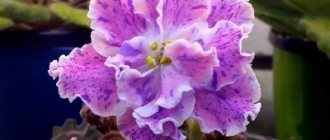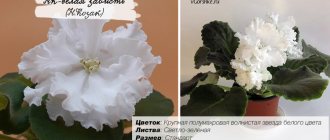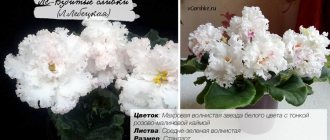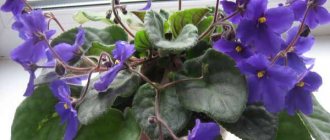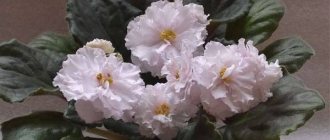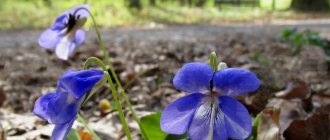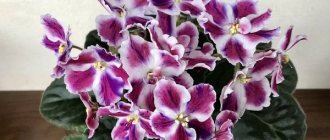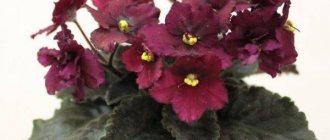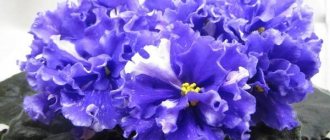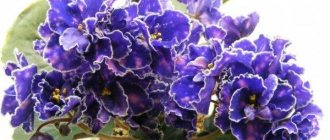Many housewives love to grow delicate indoor violets on their windowsills. There are so many varieties you won’t find at the flower market today. Most of all, many people are familiar with blue violets. Their colors range from soft blue to velvet blue. Today we will look at the most luxurious varieties of blue violets. Its scientific name is Saintpaulia, or Uzambara violet.
EK-Blue Frost
Many people like this variety for its rich cornflower blue color.
The plant is unpretentious, grows well and blooms quickly. The bush is formed in the form of a symmetrical rosette. Feels great on the windowsill and shelving. The peduncles of violet EK-Blue Frost are short. The variety is distinguished by large semi-double blue stars with corrugated petals. There is a white edging along the edges. The sockets form independently. First the leaves grow upward and then hug the pot. Blooms for a long time, in the form of a bouquet. The plant is almost always in flowers. It can go into sport and form a new variety EK-Nautilus.
The plant is distinguished by its unpretentiousness, stability, and rapid growth. Being on the windowsill, it gives a larger rosette than in the shade. Admire the Blue Frost variety in the photo below. Indeed, it seems that the flowers are covered with light white frost along the edges.
View gallery
The unique Blue Lagoon
Do you know what a lagoon is? This is a shallow body of water, connected to the sea by a narrow strait, with heavenly colored water. So, this is exactly the color of the Blue Lagoon violet. The flower is characterized by semi-double bright blue stars. In its center there is a bright blue spot. The edges of the petals resemble a purple flounce.
The bush resembles a medium-sized compact green rosette. It has a compact, flat, symmetrical shape and can reach a diameter of 30 cm. If the plant does not have enough light, it stretches its leaves upward.
The flowers are cold blue in color and reach a diameter of 6 cm. The edges of the petals are decorated with a wide soft lilac border. The variety resembles the Blue Dragon in color, but the flower shape is different. If you look closely at the flower, you will notice a green stripe at the tips of the petals. At different temperature conditions, the color of this border may change. The older the rosette becomes, the more elegant its bouquet. The plant blooms profusely, the flower stalks produce many buds. You can enjoy flowering for a long time. As soon as some flower stalks fade, new ones immediately appear. This continues for about 2.5 months. It is very easy to grow Blue Lagoon with the help of babies or leaves.
Ways to fight
If you detect signs of damage to Saintpaulia, you must first perform the following actions:
- urgently isolate the problematic specimen from neighboring plants;
- conduct a thorough examination of all nearby green pets to identify other foci of infection;
- prepare plants for treatment by removing and destroying all damaged organs;
- disinfect shelves, tools, equipment (pots, pallets, balcony boxes).
The pots are disinfected with Bioderm, the surfaces are first sprayed with a 3% solution of hydrogen peroxide, and then with 5% table vinegar. This must be done in order to prevent the spread of infection.
Depending on the scale of the disaster, the fight against pests and diseases of violets is carried out using potent pesticides or folk remedies and biological products based on plant raw materials (infusions, decoctions).
| Protector plant | What pests does it help with? | Recipes for infusions for spraying |
| Marigold | Aphid | A 10-liter bucket is half filled with plants (fresh or dried), filled to the top with warm water, and left for 48 hours. |
| Dandelion | Mites, aphids | Pour crushed roots (200 g) or fresh leaves (300 g) with 5 liters of water t up to +40°C, let it brew for 3 hours. Treatment is carried out twice with an interval of 10–12 days. |
| Chamomile | Mites, aphids | Pour crushed flowers (75–100 g) into 5 liters of water t +60°C and leave for at least half a day. Squeeze and strain. Before processing, the concentrate is diluted with water in a ratio of 1: 3. |
| Tobacco | Thrips | Tobacco (50 g) pour water (1 l), leave for 48 hours, strain, add 4-5 g of soap shavings. |
| Yarrow | Aphids, mites | Pour boiling water over 40 g of dry raw material and leave for half an hour, then add 5 liters of water, let it brew for 48 hours and strain. |
| Garlic | Aphids, thrips, fusarium, gray mold, late blight | Place several grated onions in a hermetically sealed container, add water in a 1:1 ratio, and leave to infuse for 8–10 days. Dilute 20 ml of concentrate with 10 liters of water and spray the plants. |
| Celandine | Aphids, bedbugs, caterpillars, flea beetles | Pour 100 g of dry raw materials (leaves, shoots) into 5 liters of water and leave for 48 hours. |
It is advisable to resort to chemicals only in cases of massive attacks by pests and pathogens. Pesticides of hazard classes I and II should not be used at home.
| Pests/diseases | Drugs and methods of control |
| Ticks | Treat all surrounding plants with acaricides and insectoacaricides. Preparations for spraying - “Fitoverm”, “Vertimek”, “Fufanon”, “Inta-vir”, “Agravertin”. |
| Nematodes | Destroy the affected plant along with the soil and disinfect the pot. |
| Aphid | Treat the plants with Inta-vir, Fitoverm, Fufanon, Agravertin, Aktara, water-dispersible granules (WDG), Iskra. The frequency of spraying is once a week. |
| Chervets | The soil is shed with a solution of “Regent”, “Mospilan”, “Dantop”, “Aktara” three times with an interval of 8-10 days. |
| Thrips | Treat the entire collection 5 times with a 6-day interval between procedures, alternating drugs of your choice: Fufanon, Aktara, VDG, Fitoverm, Vertimek, Actofit, Confidor, Tanrek. |
| Springtails (springtails) | In case of minor damage, drying the earthen clod helps, in the event of a massive attack, the soil should be shed with Pyrethrum, Agravertine, and any insecticides. Springtails have developed resistance to Aktara, so it is better to use Dantop. |
| Fusarium | Treat the plants with Trichophyte or Infinite. Further, a monthly two-time watering of the soil with Benomil (Fundazol) is recommended, more often in case of mass destruction. |
| Vascular bacteriosis | During May, transplant the entire collection of violets into fresh soil mixture. In cases of minor damage, treat the plants with a solution of Epin, Zircon, Previcur or Trichodermin. |
| Powdery mildew | To save violets, at the initial stage of infection they are treated with “Topaz” or “Sapropel”, which can neutralize fungi. In advanced forms of the disease, they resort to the use of “Triadimefon” (“Bayleton”). Other drugs used include Previkur, Ridomil Gold MC, Profit Gold, Amistar Extra, and Flint. |
| Late blight | For watering and therapeutic spraying, use a solution of Trichophyte or Infinito. If there are living roots, it is possible to transplant the violet into a sterile substrate in a smaller pot. |
| Gray rot | For therapeutic spraying, use a 0.1% solution of any contact-systemic fungicide, for example, Topsin M, Teldora, Sumilex, Triforin, or a mixture of 2 g of copper sulfate and 200 g of soap shavings. The frequency of treatments is once every 10 days. |
Reproduction of the variety
Violet "Nautilus" is easily propagated by both leaves and petioles. First, the resulting material must be examined for contamination or damage. After this, the Saintpaulia needs to be immersed with the bottom part in purified water. Be sure to put activated carbon in it so that it does not spoil.
Rooting is best done in a small glass cup until roots 1 cm long appear. The finished shoot can be planted in a medium-sized container, slightly deepening the edge and compacting the soil. Flush it well with settled water.
This is not yet the main place of residence. As soon as the finished rosette is three times larger in size than the pot, you can choose a larger container. Now the violet will remain in it for the whole year.
Blue variety Summer Twilight
This wonderful blue Saintpaulia became a delightful masterpiece of the breeder Konstantin Morev. Violet Summer Twilight is on the lips of many today. She was loved by flower growers for her extraordinary brightness. Sometimes it is also called Morev's violet. It is memorable for its variegated leaves and petals. This Saintpaulia forms a neat, flat, medium-sized rosette. Slightly concave quilted green leaves have a blurry white border at the edges. It is the contrast of blue and white that makes this beauty recognizable.
This variety cannot be confused with any other. It is distinguished by large double and semi-double stars up to 6 cm in diameter. Each petal in the center has a blue-violet color and a white edge. We must pay tribute to the velvety petals with a wavy edge. Bright, lush, voluminous flowers attract attention. There may be so many buds on the flower stalks that they sag under their weight.
Saintpaulia Summer Twilight blooms long and abundantly. Even young rosettes tend to bloom. Caring for this variety is not very difficult. Even beginners can wait for it to bloom. A flower pot can be placed either on a windowsill or on a shelf. The plant should be protected from too bright sun so that the white spots on the leaves do not get burned. This violet loves cool weather. In hot weather, the variegated leaves become duller. Excessive lighting leads to drooping leaves.
Violet Isabella Humako
Description of violet
A spectacular two-color variety in rich tones represents compact variations of the Saintpaulia standard.
From the beginning of its development, the violet independently and extremely carefully lays out the rosette bush in aligned contours, which allows it to acquire the neat configuration of an adult violet with a clearly calculated symmetry of the leaf plates.
Small, almost round-shaped violet leaves without a clearly pointed tip are distinguished by a quilted structure of the top layer with a slight shine to its surface, small, wavy teeth, abundant graphics of volumetric veins and a dark color of the green mass.
The configuration of the leaves involves a slight bending of the edge down.
Violet is valued for the magnificence of its blindingly colored flowers from the “pansy” segment: the petals of significant corollas fill the inner space of the bud to a simple, very rarely semi-double degree, forming a visually larger silhouette of the corolla due to their wavy border.
NOTABLE! The color palette is determined by a combination of rich shades of the cherry-burgundy palette of the main background with snow-white areas of the center and edge border.
Features of room maintenance and care
Violet Isabella Humaco is a variety with easy care and absolutely unpretentious behavior. According to its varietal characteristics, it lays out a compact rosette, grows actively, loves to bloom and does so in abundant quantities.
A feature of the variety is that it becomes more and more spectacular with each subsequent flowering. Strong peduncles help in creating lush caps and easily keep them in a straight position throughout the flowering process.
ATTENTION! To prevent the effect of completely drowning the corollas with cherry shades and provide them with greater brightness during the flowering period, it is more advisable to move the plant to cool conditions.
The length of the growing peduncles noticeably depends on the lighting conditions of the violet - with a small amount of light they become very elongated.
Care instructions
Since these crops are very delicate, they require special attention.
I would like to share some useful tips:
- during overhead watering, make sure that water does not get on the leaves and flowers;
- no need to spray plants. To hydrate, just place a cup of water nearby;
- Do not expect the desired color during the first flowering;
- maintain optimal temperature. Remember that the yellow pigment only appears at 18 degrees Celsius. As the temperature rises, the richness of the yellow tint disappears;
- violets need soft and diffused light;
- When feeding yellow varieties of violets, it is recommended to reduce the dose by half from that required in the instructions.
Domestic varieties
In addition to foreign varieties, there are very worthy trailers from domestic breeders. One of the most famous producers is N. Andreeva and her son Y. Zubo. They have created a whole series on the “river theme”, these are:
- AN-River Tarusa - ampelous standard with white-green leaf blades and double wine-colored flowers;
- AN-River Olenyok - semi-miniature trailer, with creamy green leaves and large bright pink semi-double flowers;
- AN-Krasnaya Reka - ampelous standard with a golden-green leaf blade, double, red flowers, up to 3 cm;
- 23-Amur River - standard, variegated leaf blades, large, double flowers, purple;
- 23-Yenisei River - ampelous standard with crown golden variegation and crimson double flowers and many others.
Another famous trailer breeder S. Repkina with his varieties, for example:
- RS-Klad - fantasy semi-miniature trailer, pink flowers with blue strokes and light green leaves;
- RS-Forget-me-nots - semi miniature, light green leaf plate and double lilac flowers with a darker border.
In addition, such well-known Saintpaulia breeders as A. Shcherbakov, L. Meshcheryakova, D. Glushkova periodically delight collectors with their works.
Lately, ampelous violets are increasingly gaining the attention of flower growers. They are easier to care for:
- Do not require frequent transplants;
- There is no need to constantly monitor your stepsons and cut them off;
- More tolerant of sunlight and high temperatures;
- They look very impressive;
- They bloom almost constantly and profusely.
Gift for Loved One
This hybrid has large double fringed blue flowers, along the edge of which there is a red-purple border. Violet Gift for Beloved is an exhibition plant with a perfect rosette that forms independently.
The flowers have a dark blue color and a fairly clear border. There are many buds on the peduncles, forming real caps. Large and bright flowers last a long time, up to a month and a half. The variety has positive parameters and is unpretentious to lighting.
Pay attention to the leaves of this indoor plant. They are also very decorative. They are dark green in color with a creamy pink border. Even without flowers, the rosettes look elegant.
Even a photo cannot convey all the beauty of the Gift for Beloved variety. You can really give it as a present to your man. A neat rosette looks very harmonious.
Care
The “Luntik” violet is not picky: it grows well and reproduces easily. Nevertheless, experts still advise following some simple rules.
During the watering process, it is important to ensure that water does not fall on the violet leaves. Therefore, it is better to use the drip irrigation method or watering through a tray
In addition, it is worth considering that the water in the pot should not linger, so you need to carefully calculate the volume of water and ensure drainage. As for lighting, the flower needs a lot of light. It can be safely placed on a windowsill or any other well-lit surface. At the same time, we must not forget that direct sun rays - especially direct scorching ones in the hot season - are destructive, and the plant must be protected from them. If you want to ensure violets bloom in late autumn and even winter, then you need to provide artificial lighting. Another important characteristic is temperature. The violet variety “Luntik” does not tolerate temperatures below +20°C. At the same time, it is advisable to avoid extremely high temperatures above +35°C. A necessary condition is the presence of fresh air and the absence of drafts. Most often, the plant is propagated by cuttings. But in order to confidently preserve the fancy coloring during reproduction, it is better to produce it with the help of stepchildren.
The best domestic varieties of violets
Winter smiles (B. Makuni)180 Pink large-flowered violet with worldwide recognition. The socket is massive, “standard” type. The leaves are round, light green, with a serrated edge. The flowers are double and semi-double, two-colored, star-shaped, up to 5 cm in diameter. Petals with a moderately corrugated edge, pale pink with red strokes and a narrow light green border. In winter, the color of the flowers is paler, and in summer they are rich, with a bright border. Even at home, with proper care, it exhibits cap flowering. Gives children readily, the leaf takes root well. Main advantages:
Minuses:
| 9.9 / 10 Rating Reviews One of the best retro varieties. Very attractive sports may appear. |
Sea wolf (E. Korshunova)220 The best, according to many gardeners, variety of blue violets. The socket is dense, regular in shape, “standard” type. The leaves are large, dark green, heart-shaped, with a serrated edge. The flowers are star-shaped, especially large, 7–9 cm in diameter, double, monochromatic, bright blue, with variable fine streaking, with a wavy edge. Over time, the color of the petals becomes lighter. In the first flowering, the peduncles stretch out and look sloppy, but in subsequent ones they become shorter and neater. The variety is well adapted to amateur cultivation at home. Main advantages: takes root well and produces many babies Minuses: peduncles can bend | 9.9 / 10 Rating Reviews The old leaves are very large and curved inwards - I carefully cut them off. Uneven white stripes sometimes appear on the petals. |
| A large-flowered violet variety with variable colors. The socket is symmetrical, classified as “standard”. The leaves are light green, darkening with age, and have a simple structure. The flowers are double and semi-double, two-colored, with a wavy edge, 4–5 cm in diameter. In the center the petals are red-cherry, and along the edge - with a wide snow-white stripe. In the first flowering, the size of the flowers is small and reaches a varietal maximum by the 3rd – 4th flowering. In a hot room the color is pronounced, dark cherry, and in a cool room it is pale. The width of the white border depends on the intensity of lighting: the lack of light is indicated by the expansion of the white border, sometimes only a red spot remains in the center. Main advantages:
| 9.8 / 10 Rating Reviews A very beautiful and interesting variety, I even like the variability of color. Such a capricious and fickle beauty. Although this violet does not require unnecessary care when it comes to care. |
Wedding bouquet (K. Morev)
200
Next in our rating is the white large-flowered violet. The rosette is compact, symmetrical, spreading when young, and in size occupies the lower border of the “standard” type. The leaves are typical, rounded, with a smooth edge. The flowers are double, 5–6 cm in diameter, star-shaped, with a wavy edge, snow-white in color. In a cool room, a greenish border appears. Flowering is wavy with periods of dormancy. Particularly sensitive to waterlogging and low temperatures.
Main advantages:
bouquet flowering gives many children
Cons: the flower remains half-opened for a long time
9.7 / 10
Rating
Reviews
The variety needs time to show itself: it takes a long time to form a rosette, the first blooms are less spectacular
But she will thank you for your attention and patience with a lush snow-white bouquet.
Black Pearl (E. Korshunova)190 A good large-flowered variety of dark purple violet. The socket is of the “standard” type, neat, symmetrical. The leaves are large, oblong, dark green, with a rounded end, with smooth edges, often on long petioles. The flowers are densely double, 6–7.5 cm in diameter, monochromatic, dark purple, with a velvety tint. Sometimes there is a decrease in the size of flowers with age, which is often associated with a lack of nutrition (depleted soil). Intense color is present in plants placed on a windowsill or under a lamp. Main advantages:
Minuses:
| 9.7 / 10 Rating Reviews With age, the leaves rise and the rosette becomes disheveled. I update such bushes. The variety still requires some experience. |
Violet Blue Dragon
Saintpaulia Blue Dragon has a very beautiful name, isn’t it? And the flower is even more beautiful! It is distinguished by semi-double and double stars of light blue color. In the center of the blooming rosette the flowers are dark blue, which makes them stand out very effectively. The petals have a purple or light green border. In the photo above are blue violets Blue Dragon.
It can be seen that the flower is decorated with dark green foliage with slightly jagged edges. The leaves are slightly reddish on the underside. Blue Dragon is a fairly large variety with a powerful rosette of buds and succulent leaves. The rosettes are vase-shaped. The petioles first stretch upward and then unfold into leaf blades horizontally. The emerging leaves are slightly curled, but then straighten out.
A blooming rosette of flowers resembles a terry hat. Each petal has a reddish-purple ruffled border, resembling a ruffle. Maybe the variety is called Blue Dragon because an ominous purple border appears on the light background of the flowers. This violet blooms profusely and willingly, like a bouquet. The diameter of the flower can be 7 cm. The peduncles are very persistent and elastic. There are up to 8 buds on one stem. Particularly bright flowering is observed in winter. In summer, the petioles begin to grow and the leaves rise up. The Blue Dragon owes its abundant flowering to its powerful root and leaf apparatus.
Violet Humako Flame
Description of Saintpaulia
The charming “flaming” variety of violet has a standard format. Its distinctive varietal quality is the neat, completely independent distribution of hatching leaves over the classic number of tiers of the bush.
The result is a compact, not too voluminous rosette with almost ideal silhouette contours.
Medium-sized leaves in the shape of a heart-shaped oval have a smooth surface with a quilted texture, teeth that are weakly expressed in the form of a soft wave along the contour, a uniform venation network with a main vein of increased size painted in a salad color, and a juicy, dark green color of the plates with a slight brownish tint, which appears in older leaves.
The violet forms the spatial volume of its caps from significant “pansy” flowers with a simple degree of filling with petals.
On top of the main white color in the central part of the corollas there are huge spots of varying intensity in shades of raspberry-cherry with watercolor-blurring borders.
A visual sensation is created of a flame blazing from the core of the flower.
Features of growth and care
The variety does not cause unnecessary inconvenience to gardeners during its development, it is light and easy to grow and care for, and is distinguished by the following fundamental features:
- ideal and independent layout of a neat outlet;
- the ability to bloom magnificently, voluminously and often in caps;
- strong structure of peduncles, allowing to withstand the weight of flowering caps;
- increase in the size and beauty of flower caps with each wave of budding.
A varietal feature is a certain dependence of the violet color scheme on the temperature gradient:
- in extreme heat, the petals lose their color gradation and can become completely cherry-colored;
- in cool conditions, the color of the violet remains even.
The rich world of blue Saintpaulias
Not everyone knows that Uzambara violets were originally blue in color. It was cornflower blue, indigo, and sapphire indoor beauties that conquered the world. Even in ancient times, blue symbolism was highly valued. This color was associated with modesty and purity of thought.
You may be interested in: Syngonium flower: description, photo, home care
In the article we will look at the most beautiful blue violets, their characteristics and external features. We invite you to look at a photo gallery of these indoor plants of extraordinary beauty. Below you will read in more detail a description of the 9 main blue varieties. In addition to them, it is also worth highlighting the following cornflower blue violets: Arabian Night, Aphrodite, African Night, Running on the Waves, Viscount, Misty Cloud. The Heavenly Queen violet is also very impressive. Many varieties will be described in the article.
You may be interested in: Hosta: how to propagate and grow the plant
Description
Its appearance on the market created a real sensation. Of course, fans of these flowers are accustomed to the fact that Elena Korshunova pleases them with unusual plants. But the Nautilus violet exceeded our wildest expectations.
Delicate, semi-double flowers look like stars. But even more remarkable is the color of the Nautilus violet. It really brings back memories of the depths of the oceans. It combines white, blue and deep blue tones. And the border on the petals is usually white or greenish.
Leaves complement the picture. Violet EK "Nautilus" has slightly wavy edges. They are the perfect frame for beautiful buds. She has a rich, thick green color.
Uzambara violet Magic Night
This is a truly mesmerizing flower with deep blue double flowers sprinkled with pink polka dots. Sometimes the petals are decorated with white spots, this resembles a starry sky. The velvet leaves of the Magic Night are rich green in color with original teeth. Characterized by a large but compact outlet.
Its double flowers are blue-purple. Raspberry peas on the petals make the flower very mysterious. The flowers themselves are medium in size, but there are many of them on the peduncles.
Flowering stems form a variegated cap. Flowering is quite long and abundant. For the first time, the flowers may not have peas. This variety is very unpredictable. Sometimes there are 1 - 2 spots on the petals, and sometimes there are many of them.
In a well-lit room, you can place this violet on a shelf or table. But the best place would be the windowsill. The plant loves frequent watering and reminds of this with drooping leaves. Sometimes he goes into sports, then the flowers turn purple. A very beautiful variety, you can admire it in the photo below.
How to choose?
For those who are ready for long, painstaking work, violets in the form of stepsons are suitable. For less experienced gardeners, so-called children are suitable, which are distinguished by well-developed roots and have at least 6 leaves. They can be replanted without any problems. But if there is no preparation at all, it is worth planting plants that are at least 9 months old.
Inexperienced gardeners should give preference to time-tested varieties. New products too often have many negative effects. They are characterized by capriciousness and less decorativeness. And only trained collectors can evaluate a number of properties.
Good varieties are distinguished by:
- pronounced symmetry;
- parallel arrangement of rows of leaves relative to each other;
- absence of breaks and gaps;
- dark leaves (they are more contrasting and better tolerate unfavorable conditions);
- absence of cobwebs, white plaques, plaques;
- early abundant flowering, lasting as long as possible.
Watch the following video about the most beautiful varieties of violets.
